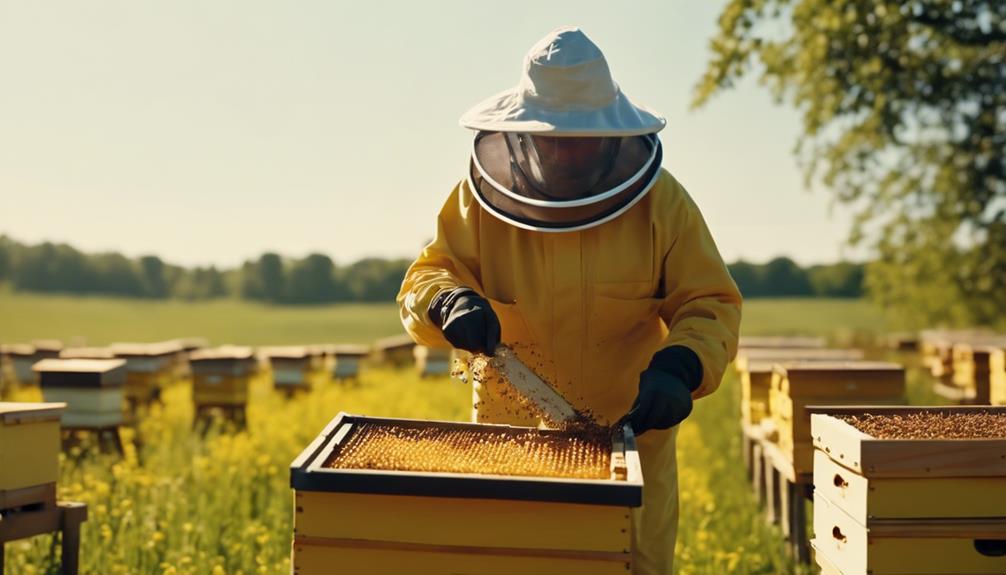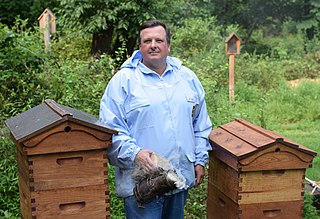
Owning bee hives can indeed be profitable if managed well. The initial investment in hives, gear, and bees is essential; plan wisely for future gains. Each hive can produce an average of 30 to 60 pounds of honey annually, depending on bee species and local conditions. Market demand for natural honey is rising, offering profit opportunities. Healthy hives are key, needing regular checks for diseases and pests. Diverse nectar sources can improve honey quality and bee health. Alongside honey sales, consider value-added products like skincare items or pollination services for added income potential. There's more to learn about maximizing profits in beekeeping.
Initial Investment Costs
Considering the initial investment costs of owning bee hives is essential for evaluating the profitability of this venture. When you immerse yourself in beekeeping, you'll need to take into account the expenses upfront. Purchasing the hives themselves, protective gear, tools, and bees can add up.
However, don't let this discourage you! Think of it as an investment in sweet returns down the line. By acknowledging these initial costs, you can plan ahead and budget accordingly. Plus, the satisfaction of harvesting your own honey makes it all worthwhile.
Honey Production Potential
So, you're probably wondering about the honey production potential of those bee hives you're eyeing up.
Well, let's start by looking at the yield per hive - this can vary depending on factors like the bee species and the local environment.
And hey, don't forget to keep an eye on market demand trends; knowing what honey varieties are popular can help you maximize your profits.
Yield per Hive
How much honey can a single bee hive produce in a year?
Well, on average, a healthy hive can yield anywhere from 30 to 60 pounds of honey annually. This amount can vary based on factors like the availability of nectar sources, beekeeper care, and the strength of the colony.
Imagine the satisfaction of harvesting your own sweet, golden honey from just one hive! It's like having a bountiful collection buzzing with goodness right in your backyard.
With each pound of honey fetching a decent price in the market, the potential profits start to add up.
Market Demand Trends
Investigating the honey production potential per hive reveals current market demand trends in beekeeping. With the rising interest in natural and sustainable products, the demand for raw honey continues to grow steadily. Consumers are becoming more conscious of the benefits of pure, locally sourced honey, creating a lucrative market for beekeepers.

By understanding these market trends, you can position yourself to meet the increasing demand for high-quality honey. Whether you're a beginner or experienced beekeeper, staying attuned to consumer preferences and market fluctuations can help you maximize your profits.
Embracing this evolving landscape allows you to adapt your beekeeping practices and cater to the ever-changing market needs. Stay informed, stay proactive, and watch your honey production thrive in response to market demand.
Equipment and Maintenance Expenses
When it pertains to owning bee hives, it's essential to contemplate the equipment costs, maintenance expenses, and budgeting for upkeep. Keeping your beekeeping tools in good shape and ensuring the hives are well-maintained can impact your overall profitability.
Equipment Costs
Owning bee hives can entail significant expenses for equipment and maintenance, impacting the overall profitability of the venture. When starting out, you'll need to invest in hive boxes, frames, protective gear, and tools like smokers and hive tools. These initial costs can add up, but they're essential for beekeeping success.
Quality equipment is vital for the well-being of your bees and the productivity of your hives. While it might seem challenging at first, think of it as setting up your bee buddies for success. Researching and investing in durable equipment upfront can save you from frequent replacements down the line. Remember, happy bees make for a thriving apiary, so it's worth it in the long run.
Maintenance Expenses
Starting with proper maintenance of Bee behavior your beekeeping equipment is key to ensuring the longevity and efficiency of your hive operation. Here are some essential maintenance tips to keep your beekeeping equipment in top shape:
- Regular Inspections: Check your hives and equipment frequently for any signs of damage or wear. Cleaning Routines: Regularly clean your equipment to prevent the buildup of debris or mold. Repair Promptly: Address any issues or damages as soon as they're noticed to prevent further problems. Storage Practices: Properly store your equipment when not in use to protect it from the elements. Replace Worn Parts: Keep an eye on the condition of your equipment and replace any worn-out parts to maintain functionality.
Budgeting for Upkeep
In order to effectively manage your beekeeping operation, it's vital to allocate a specific budget for the upkeep of your equipment and maintenance expenses. Beekeeping requires regular maintenance to guarantee the hives are in good condition, and the bees are healthy.
When budgeting for upkeep, consider costs for equipment like hive tools, bee suits, smokers, and hive boxes. Additionally, factor in expenses for routine maintenance such as hive inspections, pest control treatments, and replacing worn-out parts. It's essential to invest in quality equipment that will last longer and save you money in the long run.
Market Demand and Pricing
Why are bee hives in such high demand, and how does this affect pricing in the market?
Bee hives are buzzing with popularity due to the increasing interest in sustainability, pollination services, and honey production. This surge in demand impacts pricing, making bee hives a valuable investment for those looking to tap into the lucrative market.
Here are five key points to take into account:
- The rising awareness of the importance of bees in agriculture drives the demand for bee hives. The versatility of bee products like honey, beeswax, and propolis adds to the appeal of owning bee hives. Beekeeping hobbyists and professionals alike contribute to the demand for bee hives. Local regulations and restrictions can influence the pricing and availability of bee hives in your area. Seasonal fluctuations and environmental factors may also affect the market demand and pricing of bee hives.
Bee Health and Disease Management
Ensuring the well-being of your bee colonies through proactive health management practices is essential for sustainable beekeeping success. Regular hive inspections are critical in detecting any signs of disease or pests early on. Keep an eye out for common issues like Varroa mites, foulbrood, or nosema.
Maintaining a clean hive environment, providing sufficient nutrition, and ensuring proper ventilation can significantly boost your bees' immune systems. Consider implementing integrated pest management strategies to minimize the need for chemical treatments. If you notice any concerning symptoms, consult with experienced beekeepers or local apiary inspectors for guidance on treatment options.
Seasonal Factors and Harvesting
As the seasons change, beekeepers must carefully time their harvesting activities to maximize the yield of their hives. Here are a few key points to keep in mind:
- Spring: This season brings a burst of nectar flow, making it ideal for building up hive strength. Summer: Bees are busy collecting nectar and producing honey, so it's a great time for harvest. Fall: As temperatures drop, bees prepare for winter by storing excess honey. Winter: Minimal harvesting is done during this time to guarantee bees have enough food to survive. Weather: Keep an eye on weather patterns to plan your harvesting activities effectively.
Hive Location and Access
Choosing the right location for your bee hives is essential for their productivity and safety. When selecting a spot, consider easy access for hive inspections and maintenance.
A location with ample sunlight and natural windbreaks can help bees thrive. Make sure there's a water source nearby to keep your bees hydrated. Placing hives away from high-traffic areas can reduce disturbances and keep your bees calm.
Additionally, think about the forage options in the vicinity to provide diverse nectar sources for your bees. Remember, a well-thought-out hive location can lead to healthier colonies and increased honey production.
Value-Added Products and Services
Consider exploring additional revenue streams through the creation of unique honey-infused products and personalized beekeeping services. To elevate the profitability of your beekeeping venture, here are some exciting ideas to add value to your beekeeping business:
- Honey-Infused Skincare: Develop a line of natural skincare products using your honey. Honey Gift Baskets: Curate beautiful gift baskets featuring your honey and other local products. Beekeeping Workshops: Offer workshops for aspiring beekeepers to learn the art of beekeeping. Pollination Services: Provide pollination services to local farmers and orchards. Honey Tasting Events: Host honey tasting events to educate people about the different flavors of honey.
These value-added products and services can set your beekeeping business apart and attract a diverse customer base.
Regulatory Compliance and Licensing
Make sure your beekeeping business complies with all relevant regulations and obtains the necessary licenses to operate legally.
Before diving into the sweet world of beekeeping, it's essential to check with your local agricultural department or beekeeping association to understand the specific rules and permits required in your area.
Regulations may vary, but common requirements include registering your hives, following beekeeping best practices, and ensuring the safety of your bees and the surrounding environment.
By staying on top of these legal aspects, you can enjoy the freedom of running your bee business without the buzz of potential fines or shutdowns.
Frequently Asked Questions
Can Beekeeping Be Done in Urban Areas?
In urban areas, beekeeping can thrive with proper planning and consideration for space and regulations. By choosing suitable hive types and locations, you can enjoy the rewards of beekeeping while benefiting the environment.
How Do You Prevent Bee Stings While Working With Hives?
To prevent bee stings while working with hives, wear light-colored clothing, move slowly and avoid sudden movements, use smoke to calm bees, and wear protective gear like a bee suit, gloves, and a veil.
What Are the Risks of Pesticide Exposure to Bees?
When you expose bees to pesticides, you risk harming their health and survival. Pesticides can disrupt their natural behavior, weaken their immune systems, and ultimately lead to colony collapse. It's essential to protect these important pollinators from harmful chemicals.
Are There Any Tax Incentives for Beekeeping Businesses?
Looking into tax incentives for beekeeping businesses can lead to surprising benefits. By researching and taking advantage of available programs, you could reduce your tax burden and boost your profits. It's worth exploring!
What Are the Insurance Requirements for Beekeepers?
To operate as a beekeeper, insurance requirements vary. General liability insurance is common to protect against risks like bee stings or property damage. Research local regulations and consult with an insurance agent for specific needs.